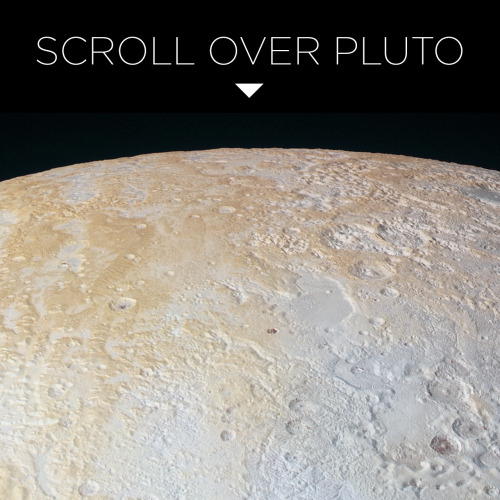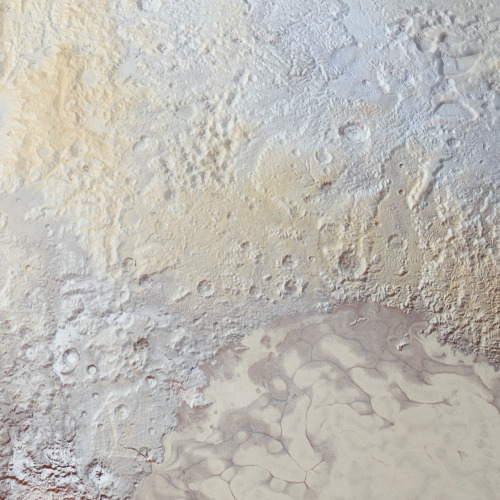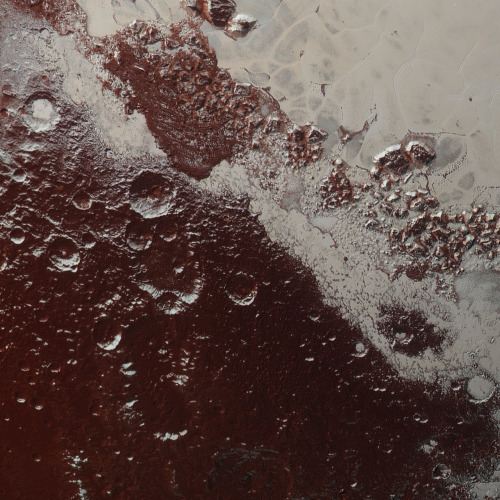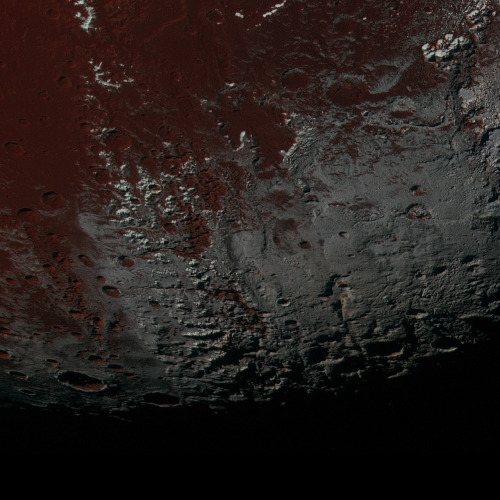I’m Sorry





i’m sorry
More Posts from Spacecheesus-blog and Others

NASA Astronomy Picture of the Day 2016 October 1
Rosetta’s Farewell
After closely following comet 67P/Churyumov-Gerasimenko for 786 days as it rounded the Sun, the Rosetta spacecraft’s controlled impact with the comet’s surface was confirmed by the loss of signal from the spacecraft on September 30, 2016. One of the images taken during its final descent, this high resolution view looks across the comet’s stark landscape. The scene spans just over 600 meters (2,000 feet), captured when Rosetta was about 16 kilometers from the comet’s surface. Rosetta’s descent to the comet brought to an end the operational phase of an inspirational mission of space exploration. Rosetta deployed a lander to the surface of one of the Solar System’s most primordial worlds and witnessed first hand how a comet changes when subject to the increasing intensity of the Sun’s radiation. The decision to end the mission on the surface is a result of the comet’s orbit now taking it to the dim reaches beyond Jupiter where there would be a lack of power to operate the spacecraft. Mission operators also faced an approaching period where the Sun would be close to line-of-sight between Earth and Rosetta, making radio communications increasingly difficult.





This is one slice of an incredible high resolution, enhanced color image of Pluto, recently released by NASA. You can see the full, larger version here.
Credit: NASA/JHUAPL/SwRI
Neat!

Traveling to Mars (safely AND quickly) with plasma rockets
There has been quite a bit of hype about getting people to Mars. But traveling 35 million miles to the red planet will require a new breed of rockets that are much more powerful and efficient than traditional chemical-fueled rockets.
It takes *A LOT* of fuel to get into space. The Saturn V, which launched spacecraft to the moon, required fuel tanks that were taller than the Statue of Liberty. Traveling to Mars, which is 200 times farther than the moon, means that we would need to build an even bigger rocket that can carry 200 times more fuel — a highly impractical quest.

So NASA researchers are working on a new kind of rocket with electric thrusters that can travel at high speed using less fuel. These plasma rockets can get spacecraft to the moon with one-tenth the tank of fuel used by Saturn V, and are capable of cutting a risky trip to Mars down from two years to less than two months.
Even though plasma rockets are ideal for long-term spaceflight, they do have some shortcomings.
To create plasma, a gas-like matter that’s as hot as the sun, radio waves are used to heat a gas propellant. The problem is that during the heating process, charged ion particles are expelled, causing damage to the thruster’s walls that could potentially lead to a catastrophe.
So what if there was a way that the wall could repair itself?
Gary Li, a UCLA aerospace engineering grad student, is figuring out a way to do just that. In the video below, he explains how his research could help humans travel safely and quickly to Mars:
[source]
![Original Post [x]](https://64.media.tumblr.com/9164df0a24ce9f5a9d7f3be756278669/tumblr_nqvr8voMrD1tpjrtho1_500.jpg)
![Original Post [x]](https://64.media.tumblr.com/03d5fcd6013e1a17f32ff9a97c5d652e/tumblr_nqvr8voMrD1tpjrtho2_500.png)
![Original Post [x]](https://64.media.tumblr.com/b44a9a8f9528c5dba4d6cf2ccfc4a196/tumblr_nqvr8voMrD1tpjrtho3_500.png)
![Original Post [x]](https://64.media.tumblr.com/adc16c664691a0d66fef5ffb6d324ef4/tumblr_nqvr8voMrD1tpjrtho4_500.png)
![Original Post [x]](https://64.media.tumblr.com/068271be7b77065000fbc01c47f44f53/tumblr_nqvr8voMrD1tpjrtho5_500.png)
![Original Post [x]](https://64.media.tumblr.com/e92cf1685d7a56d642fdd2fdd934110b/tumblr_nqvr8voMrD1tpjrtho6_500.png)
original post [x]
yes.

It’s a Spooky Universe

Consider yourself warned!
- Our universe is almost certainly going to die a heat death in which energy in the universe shall be spread so thinly that everything will freeze, the stars will burn out and not shall be left but eternal darkness.

- We might live in a multiverse. If in fact, we do: basic statistics shows that we may in fact be more likely than not be a computer program, living in a sort of simulated universe. Yes, there’s actual scientific research being done to figure out if we’re a hologram and others trying to make progress into multiverse theory.
Imagine the existential horror if we turned out to be the artificial intelligence of someone else’s universe!

- There are almost certainly a multitude of “rogue black holes”, secretly drifting through the Milky Way. If one were to drift into the solar system it could spell our end… that’s obvious though I’m sure.

- As many of you are aware, Earth’s been sending out signals for around a century now. The fact that these signals get exponentially weaker doesn’t mean they stop existing:
Who’s to say such signals can’t be detected by some advanced-and-none-too-benevolent extraterrestrial civilization?
After all, we astronomers regularly tout our exponential advancements in the search for extraterrestrial life. Maybe next time you see that light moving against a backdrop of stars it… never mind. It couldn’t possibly be…

- Certain galaxies, like M87, emit jets of matter at near the speed of light. The high amounts of energy speeding out of these galaxies could, in some cases, end life in any solar system it were to point at:

I hope all the stars above you still seem pleasant!
I’m not necessarily advocating in favor of any of these events and don’t necessarily think any of them are likely but for each item above, there are astrophysicists who do…
(Image credit: Spooky Space Kook of Scooby Doo from © Hanna-Barbera, NASA/ESA, agsandrew/Shutterstock.com, NASA, NASA/ESA/Anderson/van der Marel and NASA and STScI/AURA respectively)
I love seeing other worlds through the eyes of artists!

Artist Rendition of Saturns moon Titan
js

:( all the time
We’re With You When You Fly

Did you know that “We’re With You When You Fly”? Thanks to our advancements in aeronautics, today’s aviation industry is better equipped than ever to safely and efficiently transport millions of passengers and billions of dollars worth of freight to their destinations. In fact, every U.S. Aircraft flying today and every U.S. air traffic control tower uses NASA-developed technology in some way. Here are some of our objectives in aeronautics:
Making Flight Greener

From reducing fuel emissions to making more efficient flight routes, we’re working to make flight greener. We are dedicated to improving the design of airplanes so they are more Earth friendly by using less fuel, generating less pollution and reducing noise levels far below where they are today.
Getting you safely home faster

We work with the Federal Aviation Administration to provide air traffic controllers with new tools for safely managing the expected growth in air traffic across the nation. For example, testing continues on a tool that controllers and pilots can use to find a more efficient way around bad weather, saving thousands of pounds of fuel and an average of 27 minutes flying time per tested flight. These and other NASA-developed tools help get you home faster and support a safe, efficient airspace.
Seeing Aviation’s Future

Here at NASA, we’re committed to transforming aviation through cutting edge research and development. From potential airplanes that could be the first to fly on Mars, to testing a concept of a battery-powered plane, we’re always thinking of what the future of aviation will look like.
Make sure to follow us on Tumblr for your regular dose of space: http://nasa.tumblr.com
-
 loverofbooksandfandoms liked this · 1 month ago
loverofbooksandfandoms liked this · 1 month ago -
 melonkneesimblr liked this · 3 months ago
melonkneesimblr liked this · 3 months ago -
 veracato liked this · 3 months ago
veracato liked this · 3 months ago -
 glitchylaptop liked this · 3 months ago
glitchylaptop liked this · 3 months ago -
 sunnydust2003 reblogged this · 3 months ago
sunnydust2003 reblogged this · 3 months ago -
 sunnydust2003 liked this · 3 months ago
sunnydust2003 liked this · 3 months ago -
 glitchylaptop reblogged this · 3 months ago
glitchylaptop reblogged this · 3 months ago -
 kayn2020s liked this · 3 months ago
kayn2020s liked this · 3 months ago -
 sorisanam liked this · 4 months ago
sorisanam liked this · 4 months ago -
 starryrika liked this · 7 months ago
starryrika liked this · 7 months ago -
 heroperamuffindiplomat liked this · 8 months ago
heroperamuffindiplomat liked this · 8 months ago -
 gabriel-wolf-fox liked this · 1 year ago
gabriel-wolf-fox liked this · 1 year ago -
 trizchase liked this · 1 year ago
trizchase liked this · 1 year ago -
 mysticgardenalpaca liked this · 1 year ago
mysticgardenalpaca liked this · 1 year ago -
 fightto34 liked this · 1 year ago
fightto34 liked this · 1 year ago -
 shadowysandwichcandy liked this · 1 year ago
shadowysandwichcandy liked this · 1 year ago -
 deerpines liked this · 1 year ago
deerpines liked this · 1 year ago -
 pearlhoardingdragon reblogged this · 1 year ago
pearlhoardingdragon reblogged this · 1 year ago -
 pearlhoardingdragon liked this · 1 year ago
pearlhoardingdragon liked this · 1 year ago -
 deathofink liked this · 1 year ago
deathofink liked this · 1 year ago -
 lankysz56ms reblogged this · 1 year ago
lankysz56ms reblogged this · 1 year ago -
 lankysz56ms liked this · 1 year ago
lankysz56ms liked this · 1 year ago -
 witchcouncil liked this · 1 year ago
witchcouncil liked this · 1 year ago -
 wszxptr liked this · 1 year ago
wszxptr liked this · 1 year ago -
 lilli-the-bear liked this · 2 years ago
lilli-the-bear liked this · 2 years ago -
 idrawgaystffs liked this · 2 years ago
idrawgaystffs liked this · 2 years ago -
 wsxqazedc liked this · 2 years ago
wsxqazedc liked this · 2 years ago -
 shutupanddiehl liked this · 2 years ago
shutupanddiehl liked this · 2 years ago -
 adrianaaldridge liked this · 2 years ago
adrianaaldridge liked this · 2 years ago -
 bestofbroken liked this · 2 years ago
bestofbroken liked this · 2 years ago -
 kateinator liked this · 2 years ago
kateinator liked this · 2 years ago -
 antiquepearlss liked this · 2 years ago
antiquepearlss liked this · 2 years ago -
 zelonushka liked this · 2 years ago
zelonushka liked this · 2 years ago -
 manakalma liked this · 2 years ago
manakalma liked this · 2 years ago -
 srah-the-violist liked this · 2 years ago
srah-the-violist liked this · 2 years ago -
 37054ljh reblogged this · 2 years ago
37054ljh reblogged this · 2 years ago -
 georgeorgiaa liked this · 2 years ago
georgeorgiaa liked this · 2 years ago -
 danteslady777 liked this · 2 years ago
danteslady777 liked this · 2 years ago -
 vengesim liked this · 3 years ago
vengesim liked this · 3 years ago
Hello, folks! I mainly like to post things of the space, cartoons, and caffiene variety. Enjoy your stay! :)
37 posts